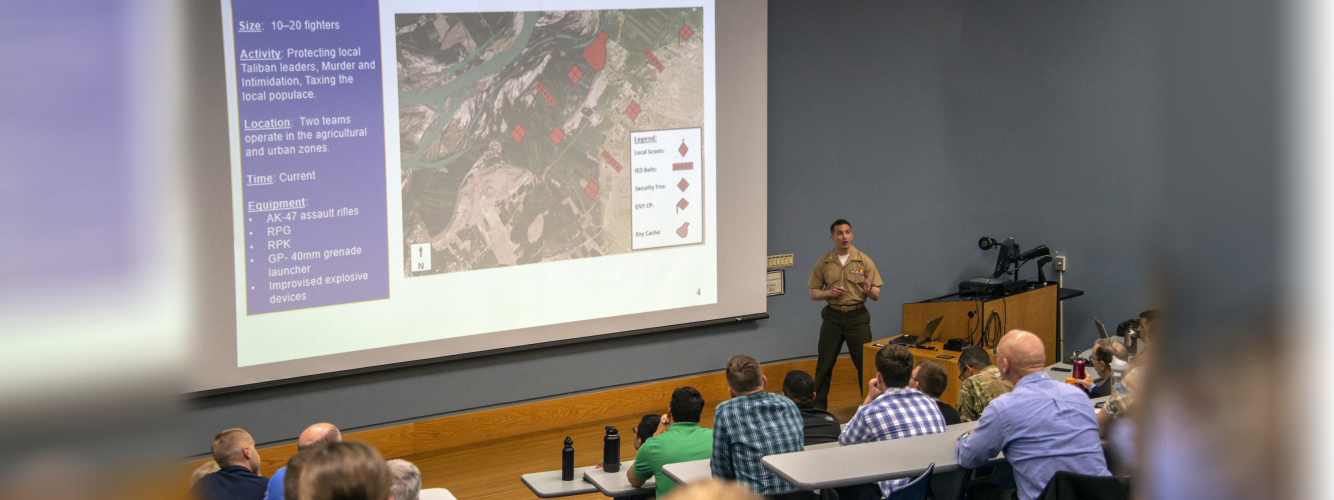Education - Climate and Security
Education
Educating the Navy’s future leaders in climate and security is critical to addressing these issues in order to meet the DoD mission. NPS classes relevant to climate and security are listed below.
Read the DOD Climate Security Learning Outcomes Memorandum.

NS4032: Special Topics—Environmental Security
Contact: Professor Emily Meierding | Email
The physical environment we live in shapes our operating environment, military and economic performance, and national interests. It creates opportunities and constraints, domestically and internationally. In short, it provides the context in which the other activities that we study at NPS occur. Yet, until the end of the Cold War, the environment was an understudied topic in Political Science and International Relations. In the last thirty years, however, many scholars and policymakers have identified the environment as a significant threat to human and national security. This seminar interrogates these claims, examining how environmental stresses, including resource scarcity, population growth, natural disasters, climate change, and pollution, trigger insecurities, including armed conflict, within and between countries. The course also examines non-violent responses to environmental stress, including migration and protest, and evaluates whether environmental stress can be a catalyst for cooperation. Throughout the course we’ll wrestle with the questions: How is the environment a security issue? Whom does it harm? How concerned should we be about environmental threats? How can we moderate environmental insecurity?
The course blends theory and practice. Through readings, discussions, and assignments, we will critically evaluate core concepts and theories of environmental security and apply them to contemporary events, such as the Syrian civil war, Hurricanes Harvey and Maria, the water crisis in Flint, Michigan, international competition over the Arctic, and the COVID-19 pandemic. You will also conduct an in-depth evaluation of environmental insecurity in a country of your choice, to enhance your regional knowledge and practice environmental risk assessment.
MR3610: Modern Climatology
Prof. Tom Murphree | Email
This course focuses on introductory investigations of Earth’s climate system, with a focus on the atmospheric and oceanic components of the system. Temporal and spatial patterns at global, regional, and local scales, with an emphasis on areas of interest for U.S. national security are covered. The course includes dynamic and thermodynamic processes that govern the climate system (for example, atmosphere-ocean-land interactions; large scale low frequency waves; teleconnections; etc.). Also included are long term means and seasonal cycles, intraseasonal to multi-decadal climate variations (for example: atmospheric and oceanic anomalies associated with Madden-Julian Oscillation, Arctic Oscillation, and El Nino-La Nina; etc.) and global warming and global climate change. Students will learn the impacts of climate variations on weather systems and the role of climate in weather analysis and forecasting. It provides an introduction to climate analysis and forecasting concepts and operations, and to the use of climate science in planning and conducting national security operations, with case studies from areas of interest. The course focuses on the atmospheric and oceanic components of the climate system, but also addresses other components (e.g., land, cryosphere, biosphere, human impacts on the climate system).
MR4250: Advanced Climatology
Prof. Tom Murphree | Email
This course addresses advanced topics in climate science, operational climate analysis and forecasting, and national security applications of climate science. The topics vary with each offering, especially in response to student interests. Topics include: (1) advanced climate analyses and long range forecasting of regional and local climate patterns and processes in areas of national security interest; (2) statistical and dynamical methods used in operational climate analysis and forecasting; (3) global climate change and its national security implications; (4) role of climate science in planning of national security operations; (5) assessments of operational climate support methods and products; and (6) student development of climate analyses, long range forecasts, and decision support products. A course focus issue will be selected based on student interests. Examples of prior focus issues: climate analysis and forecasting for regions of national security interest (e.g., Southwest Asia, Horn of Africa, east Asia, South China Sea); interactions between weather and climate phenomena; and climate change. The course focuses on the atmospheric and oceanic components of the climate system, but also addresses other components (e.g., land, cryosphere, biosphere, human impacts).
OS4621 / NS4721 Critical Infrastructure Analysis and Defense
Contact: Dave Alderson | Email, Dan Eisenberg | Email
OS4621 / NS4721 is a cross-listed course developed by Drs. David Alderson and Daniel Eisenberg to support the in-residence National Security Affairs Master's Curriculum 691 - Homeland Defense & Security. The premise of this course is straightforward: our dependence on critical infrastructures makes us vulnerable to both deliberate and non-deliberate events that can disrupt our physical, economic, and social welfare. This course develops the literacy and competencies necessary to analyze potential vulnerabilities and recommend realistic solutions for military and civilian infrastructure in the United States. Students gain experience evaluating infrastructure vulnerability through case studies on civilian and DoD systems and a course project. Fundamentally, this course is about answering the following questions:
1. What is critical infrastructure? How do infrastructure assets connect and operate as systems to provide services like electricity, water, mobility, and telecommunications? How does our dependence on these critical infrastructure systems make us vulnerable to accidents, failures, and attacks?
2. Who is involved in making infrastructure protection decisions? What policies, organizations, and regulations influence critical infrastructure operations and protection? What perspectives influence how vulnerabilities and threats are mitigated?
3. How do we evaluate critical infrastructure vulnerabilities and what can be done to protect against them? How can we make sense of the likelihood and consequences of threats to identify critical infrastructure vulnerabilities across the US? What can be done in the short-term to mitigate against them? What are the long-term strategic goals for critical infrastructure protection? What needs to be done to get there?

